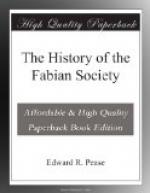This episode brings the history of the Society down to the present date, and I shall conclude this chapter with a brief account of its organisation at the time of writing, the summer of 1915.
At the end of 1913 my own long term of service as chief officer of the Society came to an end, and my colleague for several previous years, W. Stephen Sanders, was appointed my successor. The Executive Committee requested me to take the new office of Honorary Secretary, and to retain a share in the management of the Society. This position I still hold.
The tide of Socialist progress which began to rise in 1905 had turned before 1914, and the period of depression was intensified by the war, which is still the dominant fact in the world. The membership of the Society reached its maximum in 1913, 2804 in the parent Society and about 500 others in local societies. In 1915 the members were 2588 and 250. The removal to new premises in the autumn of 1914 was more than a mere change of offices, since it provided the Society with a shop for the sale of its publications, a hall sufficiently large for minor meetings, and accommodation in the same house for the Research Department and the Women’s Group. Moreover a couple of rooms were furnished as a “Common Room” for members, in which light refreshments can be obtained and Socialist publications consulted. The finances of the Society have of course been adversely affected by the war, but not, so far, to a very material extent.
The chief new departure of recent years has been the organisation of courses of lectures in London for the general public by Bernard Shaw, Sidney Webb, and Mrs. Webb, which have not only been of value as a means of propaganda, but have also yielded a substantial profit for the purposes of the Society. The plan originated with a debate between Bernard Shaw and G.K. Chesterton in 1911, which attracted a crowded audience and much popular interest. Next year Mr. Shaw debated with Mr. Hilaire Belloc: in 1913 Mr. and Mrs. Webb gave six lectures at King’s Hall on “Socialism Restated”: in 1914 Bernard Shaw gave another course of six at Kingsway Hall on the “Redistribution of Income,” in which he developed the thesis that the economic goal of Socialism is equality of income for all. Lastly, in 1915 a course of six lectures at King’s Hall by the three already named on “The World after the War” proved to be unexpectedly successful. The lecturing to clubs and other societies carried on by new generations of members still continues, but it forms by no means so prominent a part of the Society’s work as in earlier years.
Local Fabian organisation, as is always the case in time of depression, is on the down grade. The London groups scarcely exist, and but few local societies, besides that of Liverpool, show signs of life. The Research Department, the Women’s Group, and the Nursery are still active.




